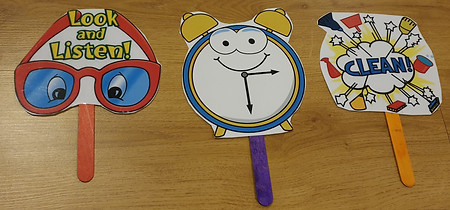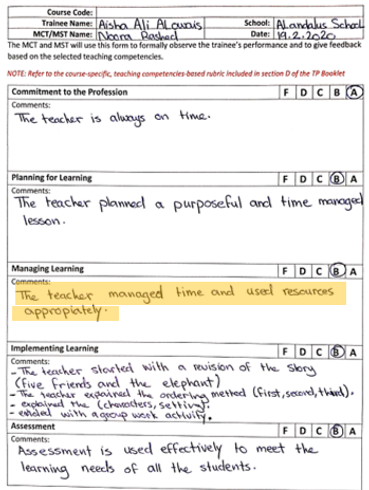Goal 2: Implementing transitions
Page overview:
This page includes details on my second goal for this semester, including the purpose, plan, and evidence.
Teaching Competency: Implementing Learning
SMART Goal
In order to make goals more attainable, a specific criteria must be followed, and this criteria uses the acronym SMART (Specific, Measurable, Attainable, Relevant, Time-based) (University of California, 2016).
Justification
Feedback from several people alerted me about my lack of explicit transitions when moving from one activity to another. Codding and Smyth (2008) explain that students become more engaged when they know what to expect during the lesson (Codding & Smyth, 2008). My goal is to enhance the flow of my lesson by incorporating transition techniques, and letting students know explicitly what we're going to be doing.
Teaching Philosophy
One of my beliefs is to provide sufficient modeling to students through gradually demonstrating content, and leading students to become independent. Implementing transition techniques requires constant modeling, especially when the routines are new to students.
Click below to view my teaching philosophy:
Goal Implementation Steps

Step 1: Note down any transitions that occur during the lesson
I wrote down the transition techniques used by my mentor, and evaluated how well they worked.
Step 2: Present my own strategies to my mentor

Before carrying out my plan, I showed my mentor a sample of the strategy I planned to use, and got her approval.

Step 3: Implement the strategies
Finally, I created the transition sticks and used them in the classroom when changing from one activity to another.
Evidence of Progress


Strategy 1: Transition Sticks
Strategy 2: Timer
The first stick means students should turn to the teacher and listen. The second stick alerts students that time is almost up. The last stick indicates that it is cleaning up time. The first few times I used this strategy, it went well, since students had understood my demonstration and followed along. Due to inconsistent modeling, students failed to follow along every time.
Students were given a limited amount of time to get their work done. It was a simple, and understandable way to bring an activity to an end. However, it is not enough as a main transition strategy.
Feedback
Mentoring School Teacher (MST)

My MST thought that I managed the lesson timing well using the resources I created. However, she mentioned that I must continue to work on using various strategies to capture students' attention for transitions.
Mentoring College Teacher (MCT)

From my MCT's observations, I was told that I had shown good awareness of timing, and managed to transition at the right times.
Reflection
While reflecting on my implementation of transitions, I noticed that it became increasingly difficult to gain students' attention when it was time to move to a different activity. I attributed this to my lack of consistent modeling. The easier techniques such as using a timer are simple to comprehend, from the perspective of students. However, a more complex technique needs more explaining, which is something I failed to do continuously, expecting that students would have already understood from the first few demonstrations. Continuous monitoring and feedback to students about how they should respond is vital for the success of transitions (McIntosh & Herman & Sanford & McGraw & Florence, 2004).
I reflected on this goal during week 3 of teaching practice. Click below to view my weekly reflections:
References:
Codding, R. S., & Smyth, C. A. (2008). Using performance feedback to decrease
classroom transition time and examine collateral effects on academic
engagement. Journal of Educational and Psychological Consultation,
18(4), 324-345. https://doi.org/10.1080/10474410802463312
Mcintosh, K., Herman, K., Sanford, A., McGraw, K., & Florence, K. (2004).
Teaching transitions: Techniques for promoting success between lessons.
Teaching Exceptional Children, 37, 32-38. https://doi.org/10.1177/
004005990403700104
University of California. (2016). SMART goals: A how to guide. Retrieved April
29, 2020, from https://www.ucop.edu/local-human-resources/_files/
performance-appraisal/How%20to%20write%20SMART%20Goals%20v2.pdf